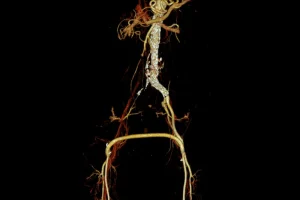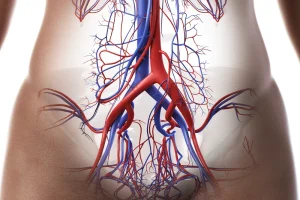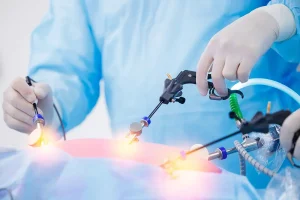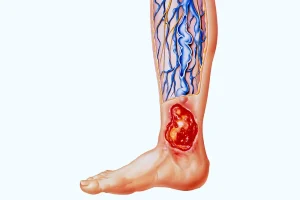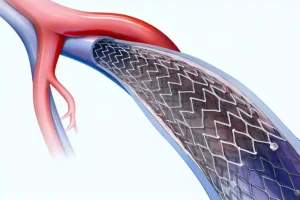Endovascular Stent Graft Arterial Angioplasty
Home » Endovascular stent graft angioplasty
Medical Procedures
Vascular Techniques
Endovascular Techniques
Conditions Treated
What Is an Endovascular Stent?
An endovascular stent is a tube made of fabric supported by a metal mesh called a stent. It can be used for a variety of conditions involving blood vessels, but most commonly to repair an aneurysm (a weak spot in an artery).
What is the role of peripheral artery angioplasty with stent grafting?
If left untreated, an aneurysm can grow over time and eventually rupture, resulting in various health problems.
Peripheral arterial stenting is designed to prevent this from happening. The stent graft fits tightly over your artery both above and below the aneurysm. The graft is stronger than the weakened artery and allows blood to flow through it without pushing on the aneurysm, significantly reducing the risk of it rupturing.
Doctors usually use endovascular stents to treat abdominal aortic aneurysms and thoracic aortic aneurysms. This technique is used less often for aneurysms located in other parts of the body.
Why is peripheral arterial angioplasty with a stent graft recommended?
Angioplasty is a modern, minimally invasive procedure in which surgeons use special technologies and instruments to ensure your safety and minimize risks.
Usually, following this procedure and with the help of endovascular treatments, the hospital stay is shorter, recovery time is much faster, there is less pain, and the risk of complications is much lower.
How is peripheral arterial angioplasty with stent grafting performed?
Before the procedure, you will receive a sedative and regional or general anesthesia, depending on the decision you make with your surgeon.
To reduce the risk of infection, the vascular surgery team will clean your skin and shave the hair in the area where the incision will be made.
Then, the surgeon will make an incision in the skin covering the femoral artery in your groin area. Your vascular surgeon will insert a guide wire into the femoral artery and advance it to the aneurysm.
Using X-rays that appear as moving images on a screen, the vascular surgeon inserts a catheter over the guide wire. The catheter carries a compressed form of the graft so that it can travel through your blood vessels. When the graft reaches the site of the aneurysm, your doctor withdraws the catheter, leaving the graft in place. The graft expands to fit snugly against the walls of your artery.
How long does it take to recover from peripheral artery angioplasty with stent grafting?
Normally, after the stent graft placement procedure, you will need to stay in the hospital for two or three days, but your recovery will begin on the first day. You will be able to eat, and the clinic staff will encourage you to take a few steps.
After you leave the hospital, there are a few things to keep in mind:
- Do not drive until your doctor gives you the go-ahead.
- You can shower, but be careful not to get the incisions in your groin area wet until they are completely healed.
- Avoid lifting weights heavier than 5 kilograms for approximately 4 to 6 weeks after the procedure.
After 7-10 days, your doctor will recommend that you return for a follow-up visit. During that visit, the doctor will check the healing of the incisions and assess your overall health.
You will then need to return for follow-up visits one month, three months, and six months after the peripheral artery angioplasty with stent graft procedure. These follow-up visits are necessary for your doctor to make sure that the stent is still working properly and is in the right place.
After that, you will need to have annual medical visits, during which your doctor will perform imaging tests to check the condition of the aneurysm.
Risks of peripheral artery angioplasty with stent graft
The chances of complications after endovascular stenting are higher in the following cases:
- If you have chronic renal failure (kidney disease)
- If you have an unfavorable type of aneurysm
- If there are blockages in the arteries near the aneurysm
- If you have already had an abdominal aortic aneurysm repaired
- If you have heart or lung disease
Complications of peripheral angioplasty with stent graft
- Bleeding around the graft;
- Infection;
- Displacement of the graft from the desired location;
- Fracture of the graft;
- Blockage of blood flow through the graft.
Endovascular stents can sometimes leak blood through the areas where the graft components join or allow blood to leak back into the aneurysm sac through the small arteries that feed the aneurysm sac.
These leaks can occur even years after the procedure and can be dangerous if the aneurysm continues to grow.
Because problems with the graft or endofilters can occur even many years after a successful placement, it is important to follow the follow-up schedule recommended by your vascular surgeon.

